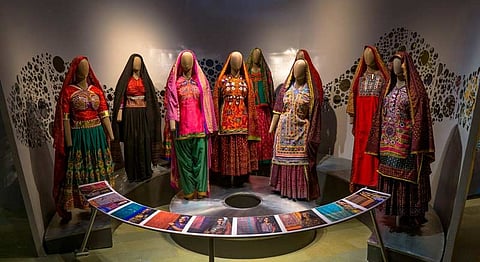
- HOMEGROWN WORLD
- #HGCREATORS
- #HGEXPLORE
- #HGVOICES
- #HGSHOP
- CAREERS
- ABOUT US
- CONTACT US

They say that you can’t know where you’re going, until you know where you’ve been. As a theory, this makes the documentation of history one of the most crucial pieces of a society’s jigsaw puzzle. In more secluded pockets of India, history is recorded through oral retellings, kept alive through stories and traditions passed down from one generation to another. And when these cultural histories are taken right from the horse’s mouth and put into written documents, kept ripe for reference and accessible to all, it provides an otherwise unavailable insight that can be used for context, anthropological research, and a general social understanding.
In 1969, Chandaben Shroff journeyed to Kutch, Gujarat with the Ramkrishna Mission to aid drought relief efforts. Visiting the Dhaneti village, she realised that the Ahir community there was reluctant to accept hand outs, insisting on being given work instead, and this sentiment was mirrored by several communities across Bhuj’s villages. Another thing that all these communities had in common, from the Jaths to the Rabaris, to the Meghwaads and more, was the intricate and diverse embroidery done by their women. As Chandaben noticed this unique craft, she decided to experiment, testing the waters for what fruit they could bear. Buying 30 saris, she asked 30 different women to use the cloths as their canvas and adorn them with their embroidery. As they were put up at an exhibition in Mumbai, the 30 pieces were sold off, with demands for more. And Shrujan Trust was born.
“Embroidery was always a personal craft for these women,” explains Ami Shroff, Chandaben’s daughter who now carries the Shrujan torch. As Chandaben, along with her husband Kantisen Shroff, helped these women convert their art into a commercial means of earning, she empowered them with work rather than free rations. The art of embroidery was passed down by the women in these various communities from grandmothers to their daughters and further. From a 110 villages across the Bhuj region, over 3000 women now earn a living through embroidery done for the non-profit organisation Shrujan Trust. And their oral craft history is now a written memoir, painstakingly recorded and documented by the Living and Learning Design Centre (LLDC), one of the branches of Shrujan. A museum on the nine acre spread of LLDC showcases each of the ten different communities whose craft this organisation documents, with sixteen distinct types of stitches recorded. Complete with mannequins draped in traditional garb, interactive digital displays, and more, the museum traces the evolution of embroidery through each community’s history.
From turbans to cradles: A display for everyone
A beautifully stitched ghodiyu [cradle for new borns] hangs in the Ahir display. The Rabari community showcase holds embroideries with motifs of thorns, which are inspired by their nomadic lives journeying through deserts. Lippin mud work with embedded mirrors forms a large, circular wall within the museum. Each unique community and their craft has a whole new story to tell, linked to history, geography and culture. And some of them are just fascinating, such as the room display dedicated to pagdis [turbans], with each community tying it in a different, distinct way. The LLDC also holds a research team that has, since 2007, dedicated their lives to recording the oral history of these women, by visiting their villages regularly and noting each aspect of their craft, then cross-checking it with other women of the same community for accuracy. As Ami says, “These mothers and grandmothers were the last safe keepers of this knowledge,” referring to how new generations aren’t as interested in the local craft traditions, creating the need to collect and document this data. Apart from embroidery, pottery, block printing and weaving also find themselves introduced here, with local artisans at their hand looms or printing stations for anyone to learn from. The LLDC craft school aims to create a learning experience, where the local arts of 10 distinct communities can be imparted to those willing to learn.
As the LLDC was inaugurated earlier this year, women who rarely left their villages were shuttled to the large property in Paddher village, 18 km from Bhuj city, to witness their art being preserved. A few minutes from the LLDC is Shrujan’s Threads of Life complex, where the creation of the raw material for their commercial crafts is done. As Mr. Deepak Jaani explains, “Women by tradition aren’t allowed to leave their villages. So local kaarigars here create the designs, and deliver it to their doorstep with the cloth and thread.” Ever since Chandaben first started the organisation to empower these women in the face of the crippling drought through commercial gains from their crafts, she has always emphasised the importance of quality. Ami narrates, “As middlemen and traders came in, none of them had quality in mind. By the late 80s and 90s, Shrujan realised that the quality that was being sold was not up to the mark.” Slowly, each of the women was taught the importance of quality work with dedication, and they reaped the benefits of the same.
“In 2006, we won the Rolex award,” starts Mr. Jaani. Chandaben was honoured with the Rolex award for her movement to revive traditional hand embroidery in remote parts of Kutch, as well as create a sustainable means of income for local women. Today, the Shrujan Trust’s Living and Learning Design Centre stands as the only tribute to Kutch’s diverse crafts in terms of recording and documenting this cultural tradition, empowering women in remote villages, and providing a space for learning as well as appreciating these fascinating, intricate arts.
